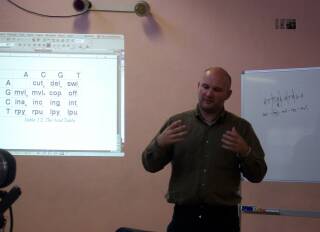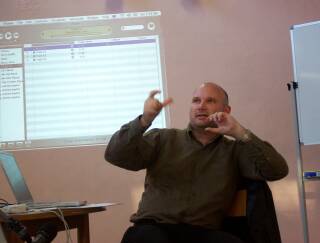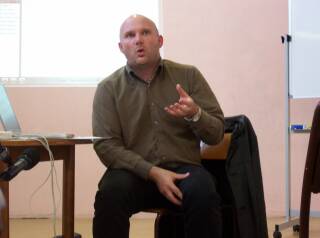


Tim Kreger - Formal systems as a means of musical exploration
reviewed by John Jenkins
Tim Kreger has a strong interest in mathematical and formal systems, as means of approaching composition and new music. A live performer and programmer, who interacts on stage with self-generating computer-based music, he is presently working with a virtual reality research project called Metraform .As a music student, he studied the last three Bartok string quartets in mathematical terms, giving him an interesting insight into the music's structure and internal logic. This involved the idea of the classical 'golden section' (also called the 'golden mean', a ratio between parts that is ubiquitous in nature and was often used by painters of the Renaissance). Kreger then examined the closely related Fibonacci number sequence, which is an early basis of fractal geometry.
Later, while studying with the Australian composer Larry Sitsky, he explored aspects of 12-tone serial music, and how systems could "generate matrices of transformation".
He says a direct legacy from Sitsky was an exposure to numerological, and musical/numerical mystical thinking, which has its roots in Pythagorean philosophy in the classical tradition, and in Kabbala in Jewish lore. Kreger found particularly useful "performance-based time principles in relationship to golden section ratios….because concepts like a temporal scale fit nicely with the Fibonacci series."
Around 1987/8, Kreger became interested in computers, and their capacity to help solve problems, studying general and musical programming with David Worrall and Virginia Read in Canberra.
For Kreger, using maths from the conceptual realm to satisfy musical models and explore their realisation in the real world became a strong preoccupation.
Douglas Hofstadter's unlikely world wide bestseller Goedel, Escher, Bach: An Eternal Golden Braid further fueled his thoughts. It looked at ideas to do with infinity, and the early theoretical seeds of artificial intelligence and, to a lesser degree, artificial life. Goedel, a 19th century mathematician and founder of Systems Theory, provided sharply challenging insights, while the book raised some very big questions: "What is intelligence and awareness; and how could he, as a composer, reconcile his musical language with the new computer paradigm?"
Next, Kreger found a simplified explanation of the DNA-RNA system and saw ways he could use similar structures to produce music. "But such ideas were always secondary to the music itself. They were always just the means to an end." His piece, ALIS - Artifcial Living Intelligence System, (1990) mimics ways in which DNA strands are self-elaborating. "This sort of thing is very difficult to replicate in software," he says. "Also, natural and living systems are, literally, infinitely more complicated than this… But I mimicked the processes of constant variation of DNA strings, to make new algorithmic musical processes, and mapping formal systems in the musical domain."
The work led Kreger to "the need to understand and develop methodologies for dealing with dynamic data schemes, and particularly population systems."
An aspect of chaos theory is the modeling of populations, which become larger or smaller over time. Of relevance here are Mandelbrot sets, in which finite arrays can generate infinite products. Keger says: "Here, I came across the concept of 'period doubling', or 'bifurcation'. This refers to the fact that there are populations that double over time, with processes that show up on the graph as bifurcated peaks, or solutions that show a doubling effect, or of generating multiple solutions over time."
Kreger's work Bifurcate (1994), for synthesiser, was based on such a process. He says, "The work uses two manifestations of the bifurcation process: a rhythmic and drone implementation." The following equation was used for "translations in terms of pitch variants":
where X is the total population, r is the rate of growth, and x is the sets of individuals under consideration. The equation generates a changing population of pitches, and, over time, this change is expressed in terms of repeated patterns of period doubling.
To obtain the drone component for Bifurcate, Kreger 'fed' a single note into the following 'conceptual machine':
where each expression is fed back into n. In other words, a population is increased, then added back onto the original population, which is in turn increased, and so on. Each event occurs at a discrete point in time, and the whole 'process' is timed; the timing produces "different effects and musical behaviours".
Kreger says, this component of Bifurcate originated from just one note, but produced large amounts of data that "…I couldn't control as a composer. So I randomly sampled the data, and came up with patterns I liked. I used them because I liked them, and because they fitted into an aesthetic of the feedback process being used."
The following set of (Gumowski) equations could also be used to produce interesting feedback loops and cumulative transformations of initial data. It was used in Kreger's 1994 piece, Mira, for MIDI-controlled guitar.
|
T = X
X = B*Y + W W = A*X + (1 - A)*2*X*X/(1 + X*X) Y = W - T
|
Finally, Kreger says, "To put it in a nutshell, what I want to do is maintain the formal and mathematical integrity of the underlying structure of pieces while producing meaningful and satisfying music. The outcome must have a real point of contact, a resonance within my own life and being. It has to be meaningful, both personally and musically. That is why working this way is such a huge challenge. And it is also why finding a solution can be so satisfying."
